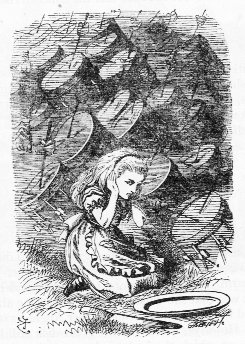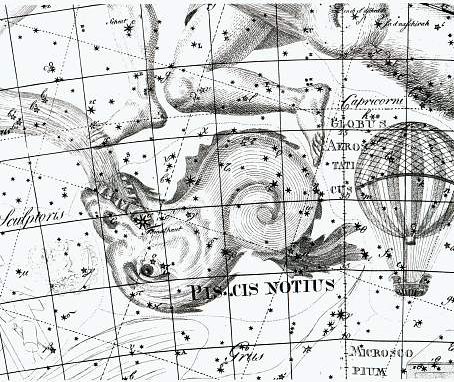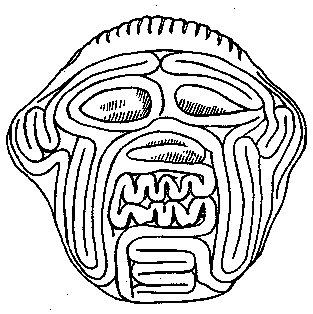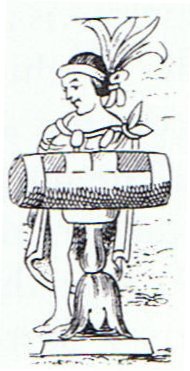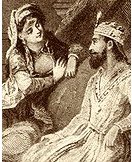|
584
36 The words of Metoro at the beginning of side b of the A tablet are evidently suggesting a close connection with his words at the beginning of side b on the C tablet:
And maybe we should therefore take account of those 670 - 664 = 6 'extra glyphs' ('sleeping mats') at the end of side a on the A tablet in order to properly position the culmination (at 21h) of Fom-al-haut (the Mouth of the Fish) at Ab1-3 (→ Cb1-9 - 6):
Which - if true - might give us this correlation between dates and glyphs at the beginning of side b of the Tahua tablet:
The glyphs on the Tahua tablet are sprinkled with minute Signs and it would have been helpful to have the Eye of an Eagle.
E.g. 677 - 541 = 136 (→ Alcyone, *136). And the limb (leg) in front in pure in Ab1-7 is depicted as 'dead', because living beings need a complete covering (shelter) in order to survive in a demanding world. ... Then she sat down on the sleeping platform and for the time being remained sitting there. At the front wall of the house she caught sight of some poor human beings, their faces were one broad grin - they had no entrails. Thus she now sat there. At last, after some time, the Moon entered, and he now said: 'Look at those poor fellows there without entrails, they are those my cousin has deprived of their entrails!'
He had given one of them something to chew, but as usual it fell down through him, where the entrails had been removed. Whenever they swallowed something, they had chewed a little, it fell right through them. The Moon now said to her: 'Look here! My poor cousin, the entrail-snatcher, he will surely come in to take away thy entrails, but now listen how to act. Thou must begin to blow and at the same time to thrust thy hands in under the front flap of thy fur coat, holding them so that they resemble a bear, then he must take himself off. Do thus, whenever thou art on the point of smiling!' Thus he told her to act ...
Expericence should have told you never to eat a mussel which already has been opened. Should you eat such food it would go right through you and out at the other end! And the bivalve depicted in Ab1-7 has its shell broken, it is open. North of the equator, in the land of the Mayas, the season of the Sun ought to be opposite to that on Easter Island, and indeed the drum (tun) lady has a perfectly good leg in front:
... The tun glyph was identified as a wooden drum by Brinton ... and Marshal H. Saville immediately accepted it ... [the figure below] shows the Aztec drum representation relied on by Brinton to demonstrate his point. It was not then known that an ancestral Mayan word for drum was *tun: Yucatec tunkul 'divine drum' (?); Quiche tun 'hollow log drum'; Chorti tun 'hollow log drum' ... ... The [tun] glyph is nearly the same as that for the month Pax ... except that the top part of the latter is split or divided by two curving lines. Brinton, without referring to the Pax glyph, identified the tun glyph as the drum called in Yucatec pax che (pax 'musical instrument'; che < *te 'wooden). Yucatec pax means 'broken, disappeared', and Quiche paxih means, among other things, 'split, divide, break, separate'. It would seem that the dividing lines on the Pax glyph may have been used as a semantic/ phonetic determinative indicating that the drum should be read pax, not tun ... Thus, one may expect that this glyph was used elsewhere meaning 'to break' and possibly for 'medicine' (Yuc. pax, Tzel., Tzo. pox) ... It should be added that tun was also the period of 18 months, or 360 days ... ... Cupping his two hands behind his ears, Ogotemmêli explained that the spirit had no external ears but only auditory holes. 'His hands serve for ears,' he said; 'to enable him to hear he always holds them on each side of his head. To tap the drum is to tap the Nummo's palms, to tap, that is, his ears.' Holding before him the web of threads which represented a weft, the Spirit with his tongue interlaced them with a kind of endless chain made of a thin strip of copper. He coiled this in a spiral of eighty turns, and throughout the process he spoke as he had done when teaching the art of weaving. But what he said was new. It was the third Word, which he was revealing to men ... Each glyph perfectly inscribed on the Tahua tablet is a picture. And each such picture carries more than a thousand words of implied meanings. ... The mythic landscape was an 'implex', by which term is meant a world of implications. ... Fanciful, assuredly, but neither the Milky Way nor the terrestrial Ganges offered any basis for the imagery of a river flowing to the four quarters of the earth 'for the purification of the three worlds'. One cannot get away from the 'implex' and it is now necessary to consider the tale of a new skeleton map, alias skambha: the equinoctial colure had shifted to a position where it ran through stars of Auriga and through Rigel. Skambha, as we have said, was the World Tree consisting mostly of celestial coordinates, a kind of wildly imaginative armillary sphere. It all had to shift when one coordinate shifted ...
|
||||||||||||||||||||||||||||||||||||||||||||||||||||||||||||||||||||||||||||||||||||||||||||||||||||||||||||||||||||||||||||||||||||||||||||||||||||||||||||||||||||||||||||||||||||||||||||||||||||||||||||||||||||||||||||||||||||||||||||
